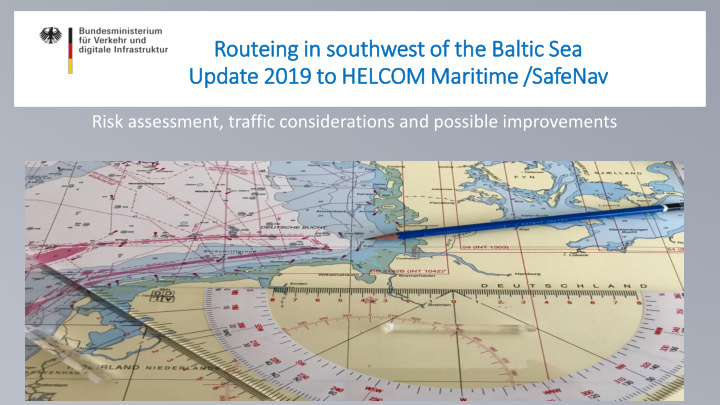



Rou outeing in n sou outh thwest of of the the Bal Baltic Sea Sea Upda pdate 2019 to to HEL HELCOM Marit Maritim ime /Sa SafeNav Risk assessment, traffic considerations and possible improvements • www.bmvi.de
SW Baltic sea 1. Area overview 2. Traffic Analysis and risk assessment (preliminary results) 3. Possible improvements
Example of maximum ship sizes Tanker shipping: L = 250 m B = 44 m T = 15.0 m LNG Shipping (Q-Max) L = 345 m B = 54 m T = 12m Container shipping (e.g. Maren Maersk) L = 400m B = 60m T = 14.5m Port limits: Rostock 16.5m planned Kiel Canal 10.5m planned Öresund Luleå 11 m (tanker) 8,0m Kemi 12.5m (?????) Klaipėda 12.5 m (tanker, LNG, container) Primorsk 15 m (tanker) T-Route Ust Luga 17.5m (tanker, container) Gdańsk 15 m (container, bulk) 15,5 m Rostock extension to 16.5m Aabenraa 18m (Bulker) NOK 9,5 m Source: Kari Liuth: Maritime cluster in the Baltic Sea region and beyond , 02.06.2019
• Weather conditions • • Most probable wind directions are S, SW and W. The frequency on the wind force is as follow: [2] [2] 0-3 Bft 41,7 % 4-5 Bft 42,3 % 6-7 Bft 14,4 % 8-12 Bft 1,16 % • The Average high of the waves is 0,9 m; between 0-1m by 74,9 %. By windless or calm sea current of 0,5 kn. In extreme situations (strong E‘ly or W‘ly winds) current of 4 kn is possible. [1] [3] • Source: [1] BSH, Naturverhältnisse Ost Se, 2008, pp. 10-12; [2] Admiralty Sailing Directions NP 18, 2018; [3]BSH, Berechnete Strömungen des operationellen Modellsystems des BSH, 05.082019 • – – –
Bathymetry Water depth is limited Vessel with draft over 12 m are restricted in there movement in the area of Öjet und Kadetrinne Source: EMODnet,2019
Nature Protection Areas Since 2005 recognised as a Particularly Sensitive Sea Areas (PSSA) NATURA 2000 areas: Fehmarnbelt Kadetrinne Plantagenetgrund Darss Source: Natura 2000 End 2018 - Shapefile, 2019
Offshore wind expansion Wind park Status Arcadis Ost 1 Consent Authorised Kriegers Flak II Consent Authorised Fully Commisioned, Arcona&Wikinger Concept Authorised Baltic Eagle Consent Authorised Baltic 2 Fully Commisioned Gennaker Consent Authorised Kriegers Flak Pre-Construction Kriegers Flak Pre-Construction Rødsand 2 Fully Commissioned Nysted Fully Commissioned Source: FEP 2019 (BSH), LEP M-V 2016, 4COffshore
Pleasure crafts When pleasure vessels cross “open water”, they prefer to go in straight lines between the harbours. Pleasure vessels generally try to avoid sailing in TSS and deep water ways Not more then 25 % have AIS transmitter. Source: FEP 2019 (BSH); LEP M-V 2016; 4COffshore;
Fishing vessels the fishing efforts variable between the months and the years. Main fishing areas are N‘ly of Ruegen, N’ly of Wismar and the Bay of Kiel. Source: Thünen-Institut für Ostseefischerei (OF), 2019
Commercial shipping Around 33 thousand vessel paused trough Fehrmann Belt and 47 thousand Kadetrinne in 2017 Route “T” ( Vessel are following recommended routes New offshore structures may increase the risk of collision and groundings Source: GDWSFEP 2019 (BSH); LEP M-V 2016; 4COffshore;
Accidents at sea 2007-2017 (HELCOM data set) Source: HELCOM, Shipping accidents, 2018; 6FEP 2019 (BSH); LEP M-V 2016; 4COffshore;
SW Baltic sea 1. Area overview 2. Traffic Analysis and risk assessment (preliminary results) 3. Possible improvements
Fehmarn- traffic distribution 22000 10000 Fehrmann H-Route Kiel Kiel Kiel- T-route T-route Fehrmann H-Route H-Route H-Route Kiel- Kiel-T- Kiel-T- Belt Belt (Fehrmann) (Langeland) (Langeland) Fehrmann Fehrmann Route (Fehrmann) (Langeland) (Fehrmann) Route 36000 30000 20000 10000
Fehmarn- Risk Assessment preliminary results! Complex traffic in this area with several crossing traffic High since streams most ships pass through here Traffic joinincg here gives relatively high risk of collisions
Kadetrenden- traffic distribution 26000 20000 10000 ITZ Fehrmann ITZ Center North West East Belt West East Gate Kadetrenden Kadetrenden Kadetrenden 46000 40000 30000 20000 10000
Kadetrenden- preliminary results! Traffic joinincg here gives relatively high risk of collisions High since most ships pass through here Complex traffic in this area with several crossing traffic streams Ships on routes inside ITZ are generally sailing along the same lines in both directions, whereas ships in and entering/exiting TSS Kadetrinne tend to divide into lanes. This leads to relatively fewer head-on collisions. Source: Ramboll, 2019
SW Baltic sea 1. Area overview 2. Traffic Analysis and risk assessment (preliminary results) 3. Possible improvements
TSS Öjet (Fehrmarn)
TSS Öjet (Fehmarn) slight adjustments new TSS W'ly of Fehmarnbelt Separation zone on flat area “ Öjet ” Possible extension of the deep water path to the Great Belt
TSS Öjet (Fehmarn)
Kadetrinne, „South of Gedser “ Ship Types- East Gate 6000 5000 4000 3000 2000 1000 Fast ferry Fishing General Tanker Other Passenger Pleasure Support Cargo Ship Draught- East Gate 3200 2000 1000 < 1.5 6-7.5 10.5< 1.5 - 3 3 - 4.5 4.5 - 6 9 - 10.5
Kadetrinne „South of Gedser ” connecting TSS „South of Gedser “ and „North of Rügen Distance Gennaker – Trafic Lane 1,8 sm Threading, unthreading N- going traffic Coastal traffic zone east border to Arkona Adjustment of buoyage (lateral system)
Kadetrinne
Discussion
Recommend
More recommend